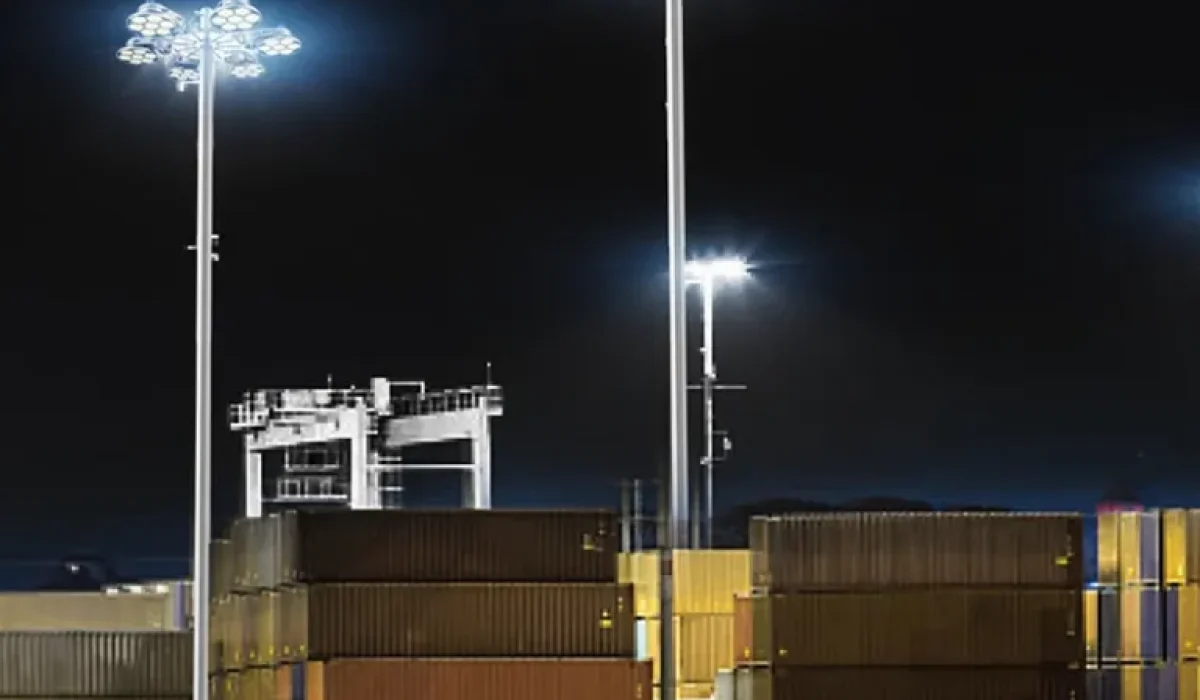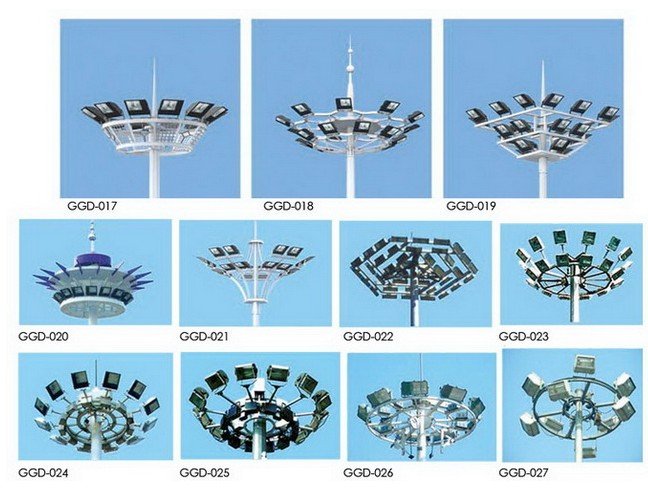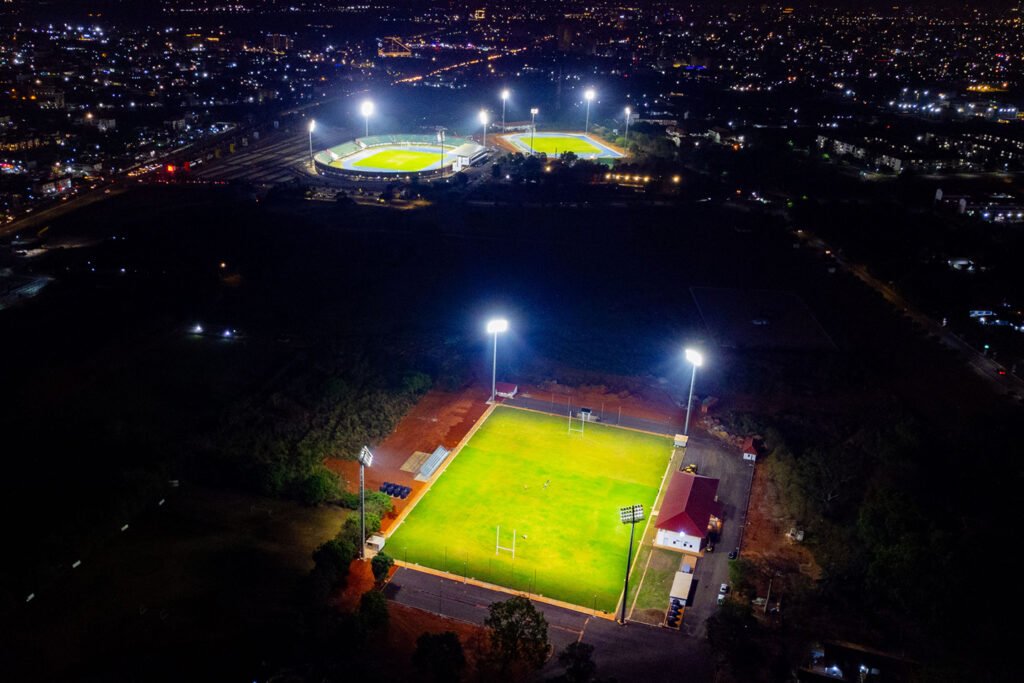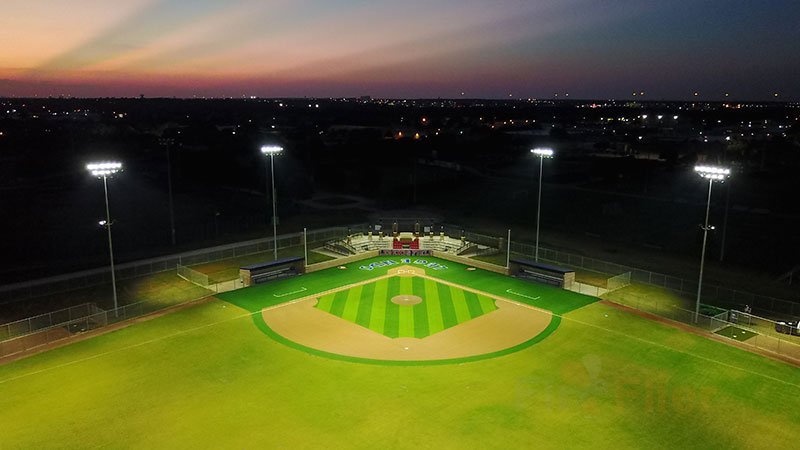I don’t design high mast lighting to make drawings pretty; I do it so trucks don’t crash, pilots see the apron line, and city managers stop getting angry calls at 11 p.m. In 2025, the best designs balance uniformity, glare control, and energy (and yes—budget). It’s science with muddy boots.
What problem are we actually solving at night in ports and highways?
We’re solving for safe visibility, not just “more lux”, by hitting the right average illuminance and keeping uniformity and glare inside limits the crew can live with.
On paper, a yard might “meet 80 lux average.” On the ground you’ll hear: “Blind spot behind the reefer stack,” “driver can’t see lane markings,” “glare into the tower’s windows.” The fix is rarely “add wattage.” It’s beam shape, mounting height, and spacing—plus a realistic maintenance factor because dust and salt never read your spec.
- Typical target ranges:
- Interchanges & toll plazas: 30–50 lux avg, U₀ ≥ 0.4
- Container yards: 50–100 lux avg, U₀ ≥ 0.4–0.5
- Stadium parking: 30–75 lux avg, U₀ ≥ 0.35–0.4
- Airport apron (service zones): 100–150 lux avg, U₀ ≥ 0.4
“Good enough” is dangerous; a patchy 120 lux feels worse than a smooth 70 lux. Ask the forklift guys.
How do I size illuminance without pretending it’s perfect?
Use the classic flux–area method for a first pass, then verify with photometric files and layout software—because UF and MF are never fixed numbers in the wild.
E (lux) = (Φ_total × UF × MF) / A
- Φ_total = total lumens from all heads on a mast or zone
- UF = utilization factor (0.6–0.8 typical for asymmetric floods 20–40 m high)
- MF = maintenance factor (0.75–0.85 inland; 0.7 coastal)
- A = illuminated area (m²)
Example: 30 m mast, 6 × 400 W LED floods (≈ 600 000 lm total) over 60 × 60 m yard.
E ≈ (600 000 × 0.7 × 0.8) / 3 600 ≈ 93 lux — good for an industrial yard or apron.
Common mistakes:
- Assuming UF from a 20 m chart works at 35 m—it doesn’t.
- MF = 0.9 because “LEDs don’t decay.” Dirt does.
- Ignoring tilt: 5–10° mis-aim kills uniformity.
Which pole heights and optics actually work?
Taller poles need tighter beams to control glare; shorter poles tolerate wider optics but increase mast count.
| Application | Pole Height (m) | Heads/Mast | Typical Optics (°) | Target Avg Lux |
|---|---|---|---|---|
| Highway junction | 25–30 | 4–6 | Asymmetric 30–45 | 30–50 |
| Container yard lanes | 30–35 | 6–8 | Narrow-medium 25–40 | 50–100 |
| Stadium parking | 20–25 | 4–6 | Medium-wide 45–60 | 30–75 |
| Airport apron | 35–40 | 8–12 | Narrow 20–40 + visor | 100–150 |
If your beam’s too wide at 35–40 m, glare spikes and near field washes out. One extra mast with clean optics beats “spray and pray.”
How far apart should masts be spaced?
Aim for U₀ ≥ 0.4 and 50 % beam overlap; diamond or circular layouts beat rigid grids.
| Pole Height (m) | Spacing (m) | U₀ Expected | Typical Use |
|---|---|---|---|
| 20 | 50–55 | 0.35–0.40 | Intersections |
| 25 | 60–70 | 0.40–0.45 | Industrial yards |
| 30 | 80–90 | 0.40–0.50 | Highway interchanges |
| 35 | 90–110 | 0.45–0.50 | Container terminals |
| 40 | 110–130 | 0.50 | Aprons, stadiums |
Why diamond? Overlap lands where gaps used to be. Square grids leave dark corners. And always walk the site—CAD can’t see cranes or billboards.
What 2025 control trends actually cut OPEX?
Blend scheduled dimming with sensor boosts, keep local fallbacks, never rely on one radio link.
- DALI-2 / 0–10 V: time-based scenes (100 % → 70 % → 50 %).
- Presence sensors: microwave or video analytics per lane; tune to avoid false triggers.
- IoT platform: LoRaWAN/NB-IoT for monitoring and fault alerts; include local fail-safe mode.
- Spill-light curfews: down-tilt + visors satisfy both neighbors and audits.
- Battery backup: short-autonomy LiFePO₄ for egress safety when grid fails.
Savings: 30–45 % energy vs flat operation, plus longer driver life.
Wind, corrosion, and foundations—the things that bite later
Design for site wind, galvanize properly, and never guess anchors.
- Wind: use national maps (Eurocode 1 / AS1170). Include luminaire windage; check damping for vortex shedding.
- Corrosion: hot-dip galvanize inside/out (ISO 1461, ≥ 85 µm zinc); vent holes; touch-up welds.
- Foundations: confirm geotech—bearing pressure, water table, backfill. Anchor-bolt templates must ship with cages.
- Earthing: ≤ 10 Ω typical target; surge protection rated to system voltage.
- Access: if 40 m lifts aren’t available, specify lowering headframes.
| Item | Minimum Spec | Why it matters |
|---|---|---|
| Steel grade | Q345 / EN S355 | Stiffness at height |
| HDG | ISO 1461 ≥ 85 µm | Coastal durability |
| Bolts | Class 8.8 + template | Alignment accuracy |
| Door | IP65 + SS hardware | Weather, theft |
| Cable path | Smooth grommets | Avoid chafing |
| Marking | Height + CoG label | Safe craning |
Field example: Lusaka 2025 corridor upgrade
We used 30 m masts with asymmetric optics to light an interchange bordered by apartments.
- Height: 30 m hit coverage without glare complaints.
- Heads: 8 × project-grade LED floods, ~120 klm per mast.
- Spacing: 85–90 m diamond; extra mast near crossings.
- Controls: DALI-2 time profiles + on-ramp sensors.
- Foundations: deeper pedestal for sandy soil, denser backfill.
- O&M: headframes matched 30 m lift truck; spare drivers on site.
Result: fewer complaints, consistent light, maintenance crews happy.
Quick reference lux & uniformity targets
| Area | Avg Lux | U₀ (min) | Comment |
|---|---|---|---|
| Interchange / toll plaza | 30–50 | 0.4 | Lane visibility |
| Urban arterial | 20–30 | 0.4 | Blend with road lights |
| Stadium parking | 30–75 | 0.35–0.4 | Control glare |
| Container yard | 50–100 | 0.4–0.5 | Shadow control |
| Airport apron | 100–150 | 0.4 | Strict spill limits |
Small dips below 0.4 U₀? Check tilt before adding fixtures—2° can recover 0.05 easily.
Cost focus: where to save, where not to
- Save watts with controls, not by deleting masts.
- Lower CCT (4000 K → 3500 K) improves comfort, zero cost.
- Avoid cheap wide-beam floods; precision optics pay off.
- Never thin the zinc coat—rust is a silent OPEX.
Commissioning checklist
- Check pole plumb & torque, photo proof.
- Confirm tilt per layout.
- Measure grid: avg, min, U₀; record meter ID.
- Glare check at eye level.
- Test control scenes: outage, sensor fail.
- Verify spill light boundaries.
- Label circuits, earthing continuity.
- Deliver a one-page O&M sheet the crew actually reads.
Common design traps
Dark mast base → adjust tilt or add near-field fill.
Hot crane zones → narrower beam, shift mast 5–10 m.
Neighbor glare → cut-off shield + dimming scene.
“Lights stuck at 100 %” → driver fallback not set.
Bolt mismatch → lost templates; always ship with cage.
Final thought
High mast lighting is half math, half diplomacy with shadows.
The best nights are when the guard says, “I can finally see that corner,” and no one notices the lights again. If you design with that in mind—height, spacing, optics, wind, and maintenance—you’ll sleep well too.





